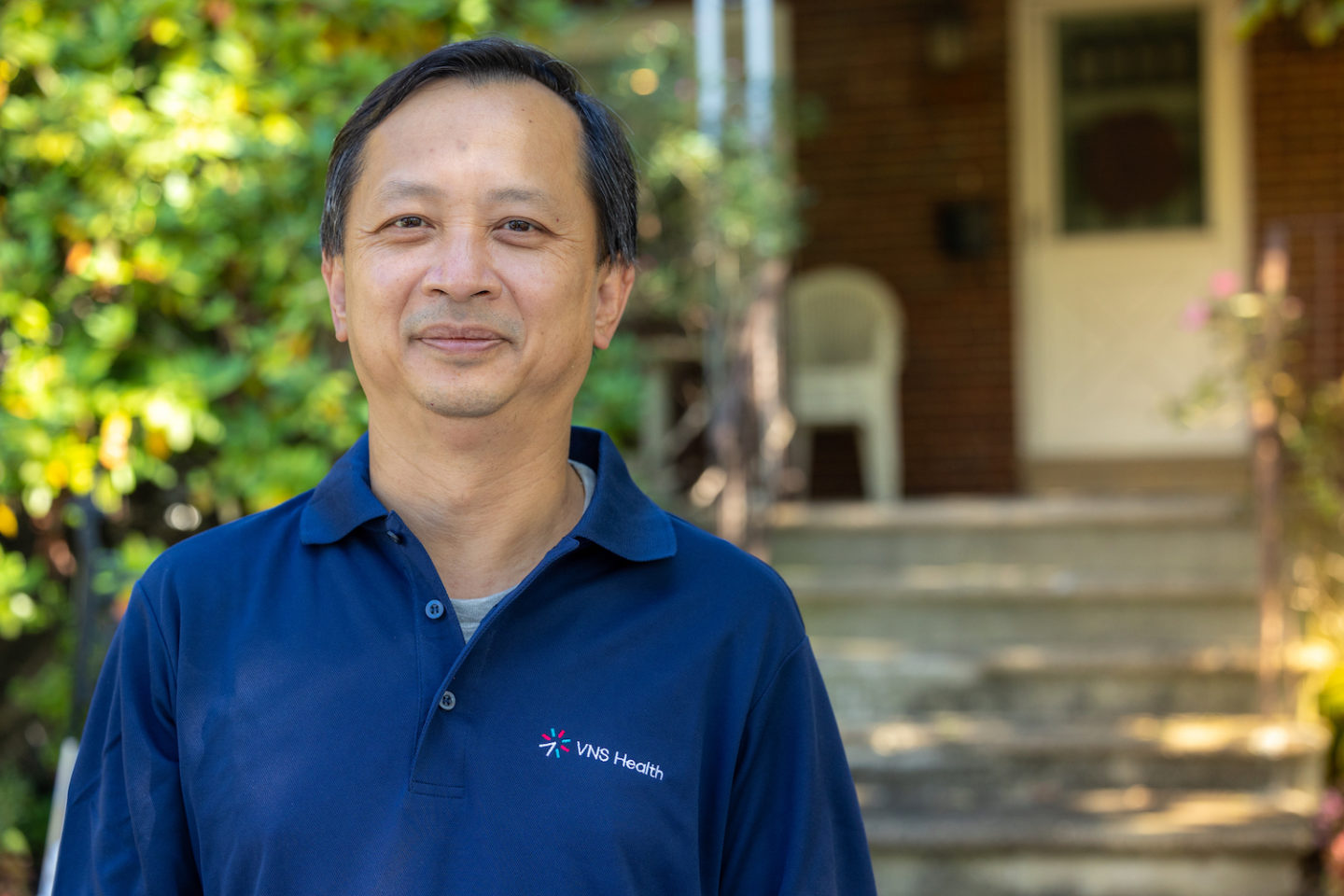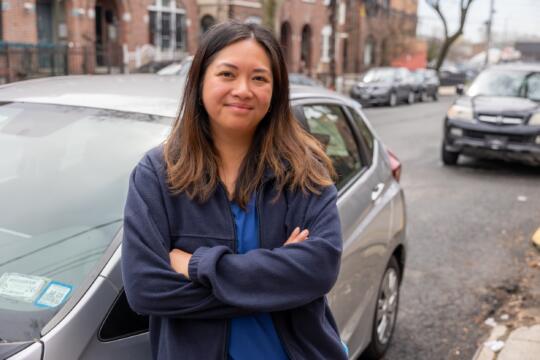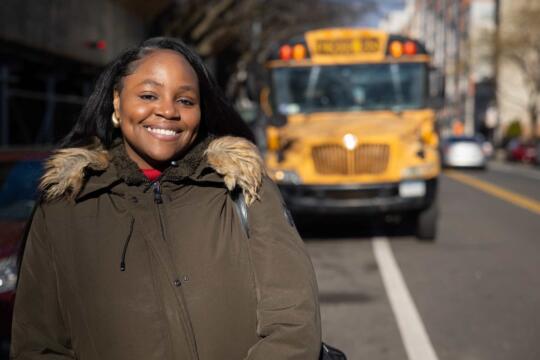Follow Physical Therapy Professional of the Year Simon Chan as He Takes Us Through a Day in His Life!
Welcome to another edition of “A Day in the Life”—a Frontline series that follows team members from different parts of VNS Health as they go about a typical day at work.

October is National Physical Therapy Month—which makes this the perfect time to highlight physical therapist Simon Chan, VNS Health’s 2022 Physical Therapy Professional of the Year. (Congratulations, Simon!) A 26-year VNS Health veteran, Simon tends to clients across Queens, doing home visits from Monday through Friday each week as well as occasional weekend assignments. We asked him to walk us through a sample day in his action-packed schedule.
7:20 a.m.
The first thing I do after I wake up is take my kids to school. I get back home a little after 8:00 and have a big breakfast, because I eat lunch very late—and sometimes skip it altogether if I’m extra busy. While I’m having breakfast, I also schedule my visits for the day. This is a new step we do now—we enter the time we plan to see each patient, so they can go to their computers if they want to check when I’m coming that day.

My normal caseload is 35 or more visits per week, and that can go up to 45 in the summer when many PTs take days off. Though I do have a set schedule with my regular clients, sometimes appointments need to be moved to different times. It all depends on the day and my caseload. Mondays and Fridays tend to be crazy. On Mondays, I often have to fit in new visits—for instance, if someone fell over the weekend or had a total knee replacement on a Saturday, they’ll need to be seen that Monday. When I get these last-minute priority cases, I try to juggle my schedule to accommodate them. Fridays are usually busy too, filled with patients who canceled on me earlier in the week. I might start the week with two patients on my schedule for Friday, but by the time Friday arrives I’ll have eight to ten. I’m in touch with my scheduler via email all day long, getting updates. Home care is all about agility and flexibility!
9:30 a.m.
Most of my patients are in their 80s and 90s. They are recovering from any one of a range of things: total knee or hip replacements, fractures after a fall, strokes, accidents—or medical conditions like Parkinson’s, internal bleeding and other issues. I love working with my geriatric patients and I am very attached to them.

Most of my patients don’t want to see me before 9:30 or 10:00. I work and live in Queens, which is a huge borough, so I drive to my appointments. I head out the door in plenty of time to get where I’m going, since there’s a lot of traffic on the Long Island Expressway. Once my car broke down and I had to take a bus to my appointments, carrying all of my equipment. It took forever!
On a typical day, I see six or seven patients. The commute between my regular clients is pretty easy—maybe ten minutes driving, tops. If I’m asked to fill in for an additional client outside of my area, it takes longer. We’re a very busy team, and I always try to accommodate such requests—especially if it’s a priority case. I only say “no” if I know I’d be late or if it would inconvenience too many other patients to change their appointments. This year, our team was able to hire a per-diem PT, which has been very helpful.
12 p.m.

Noon is lunchtime for many people, but I don’t eat lunch until late afternoon—if I have it at all. A lot of my patients request lunchtime appointments. Also, the more work I get in early in the day, the better. I spend about 45 minutes with each patient, and then I have to drive to the next visit, so working through the noontime hour is the most efficient use of my time, and the best way to accommodate my caseload and to get home at a reasonable hour.
You never know what each day, client, or living situation will bring, so I have to be creative. If a patient doesn’t have a therapeutic table and their bed is too high or too low for therapy, I have to figure out another way to use what they have in the home. I often recommend equipment or changes to a client’s home as well. When you’re doing home care, you work with the home environment as well as the person. For example, I have a short client who is now able to walk with a cane, but he can’t lift his legs enough to get into his bathtub, which has very high sides, so he’ll need to change that to a walk-in shower.
3:30 p.m.
If I eat lunch, this is around the time I might grab a quick bite. It’s also the time we have Thursday Zoom team meetings once a month. The meetings are an hour long and cover things like compliance, reminders and specifications about paperwork, Medicare regulations, and any other issues we need to know or be reminded of. On those Thursdays, I need to reschedule any visits that regularly happen at that time.
5:30 p.m.
I’m usually finished with my last patient at 5 o’clock, so I head home then and take a break. I’ll go for a half-hour jog, take a shower, cook dinner and watch a little TV. It’s important to recharge.
Evening

Now for the only part of my job that I don’t love– the paperwork! I have to write notes about all of the day’s cases, and each case takes a minimum of 10 minutes if it’s routine. Evaluation cases take more time, and if I’ve opened a case, that takes even longer. When a nurse has opened the case, that saves a lot of paperwork for me. But if it’s an orthopedic case, such as a total knee or total hip replacement, a nurse isn’t needed because it’s a rehab case only—there are no issues that require a nurse’s care, like staples to remove. So those are the cases I open. If I find myself with breaks during the day, like extra time between patients or a last-minute cancellation, I’ll use that time to get a head start on that evening’s paperwork. Of course, when someone cancels, I have to do a note about why they canceled!
Weekends

In addition to our weekday schedules, the PTs on our team take turns filling in on weekends. Weekends are a totally different thing. I’m usually assigned cases outside my regular territory, which is actually good because I like to experience a completely different area. Weekends can also be a little unpredictable. On a recent Sunday, I was assigned five cases, but only one patient wanted to see me! I always call ahead, so I’m not surprised by a no-show or cancellation when I arrive there.
I love my job. Working one-on-one is the best thing about it. Before I started at VNS Health, I did outpatient physical therapy, where I was working with three or four patients at the same time and it was hard to follow up with them after they were done. Seeing my patients progress over time is wonderful—seeing them get better, seeing them walk again. A lot of patients are so depressed and frustrated after surgery. Just imagine not being able to get to the bathroom, or having someone change your diaper. I keep telling them that things will get better and they will get back to normal, but they don’t believe me at first. Then they learn to walk again, and are able to take a shower and regain their independence, and they’re so happy!


